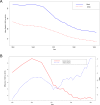Measuring health disparities: a comparison of absolute and relative disparities
- PMID: 26623191
- PMCID: PMC4662578
- DOI: 10.7717/peerj.1438
Measuring health disparities: a comparison of absolute and relative disparities
Abstract
Monitoring national trends in disparities in different diseases could provide measures to evaluate the impact of intervention programs designed to reduce health disparities. In the US, most of the reports that track health disparities provided either relative or absolute disparities or both. However, these two measures of disparities are not only different in scale and magnitude but also the temporal changes in the magnitudes of these measures can occur in opposite directions. The trends for absolute disparity and relative disparity could move in opposite directions when the prevalence of disease in the two populations being compared either increase or decline simultaneously. If the absolute disparity increases but relative disparity declines for consecutive time periods, the absolute disparity increases but relative disparity declines for the combined time periods even with a larger increase in absolute disparity during the combined time periods. Based on random increases or decreases in prevalence of disease for two population groups, there is a higher chance the trends of these two measures could move in opposite directions when the prevalence of disease for the more advantaged group is very small relative to the prevalence of disease for the more disadvantaged group. When prevalence of disease increase or decrease simultaneously for two populations, the increase or decrease in absolute disparity has to be sufficiently large enough to warrant a corresponding increase or decrease in relative disparity. When absolute disparity declines but relative disparity increases, there is some progress in reducing disparities, but the reduction in absolute disparity is not large enough to also reduce relative disparity. When evaluating interventions to reduce health disparities using these two measures, it is important to consider both absolute and relative disparities and consider all the scenarios discussed in this paper to assess the progress towards reducing or eliminating health disparities.
Keywords: Absolute disparity; Health disparities; Relative disparity.
Conflict of interest statement
The authors declare there are no competing interests.
Figures
References
-
- Agency for Health Care Research and Quality National healthcare disparities report. 2013. Available at http://www.ahrq.gov/research/findings/nhqrdr/nhdr13/2013nhdr.pdf (accessed 7 July 2015)
-
- Andrulis DP, Siddiqui NJ, Purtle JP, Duchon L. Patient protection and affordable care act of 2010: advancing health equity for racially and ethnically diverse populations. Joint Center for Political and Economic Studies. Available at http://jointcenter.org/sites/default/files/Patient%20Protection%20and%20... (accessed 7 July 2015)
-
- Centers for Disease Control and Prevention CDC Health disparities and inequalities report—United States, 2013. MMWR Supplement Vol. 62/ No. 3. 2013. Available at http://www.cdc.gov/mmwr/pdf/other/su6203.pdf (accessed 7 July 2015) - PubMed
LinkOut - more resources
Full Text Sources
Other Literature Sources


